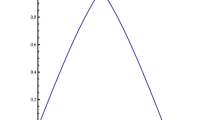Summary
We present a reverse Chaikin algorithm which generates a multiresolution representation of any line chain. It has applications in multiresolution editing and compression. We also sketch how this might be extended to the bivariate Loop subdivision algorithm.
Access this chapter
Tax calculation will be finalised at checkout
Purchases are for personal use only
Preview
Unable to display preview. Download preview PDF.
Similar content being viewed by others
References
G. M. Chaikin. An algorithm for high-speed curve generation. Computer Graphics and Image Processing, 3:346–349, 1974.
D. Douglas and T. Pücker. Algorithms for the reduction of the number of points required to represent a digitised line or its caricature. The Canadian Cartographer, 10:112–122, 1973.
K. Hormann. An easy way of detecting subdivision connectivity in a triangle mesh. Technical Report 3, Department of Computer Science 9, University of Erlangen, May 2002.
Andrei Khodakovsky, Peter Schröder, and Wim Sweldens. Progressive geometry compression. In Proc. ACM SIGGRAPH 2000, pages 271–278, 2000.
C. T. Loop. Smooth subdivision surfaces based on triangles. Master's thesis, University of Utah, Department of Mathematics, 1987.
R. F. Riesenfeld. On Chaikin's algorithm. Computer Graphics and Image Processing, 4:304–310, 1975.
F. Samavati and R. Bartels. Multiresolution curve and surface representation by reversing subdivision rules. Computer Graphics Forum, 18(2):97–119, 6 1999.
F. Samavati, N. Mahdavi-Amiri, and R. Bartels. Multiresolution surfaces having arbitrary topologies by a reverse Doo subdivision method. Computer Graphics Forum, 21(2):97–119, 6 2002.
E. J. Stollnitz, T. D. DeRose, and D. H. Salesin. Wavelets for computer graphics. San Francisco; Morgan Kaufmann Publishers, 1996.
Vitaly Surazhsky and Craig Gotsman. Explicit surface remeshing. In Proc. Eurographics Symposium on Geometry Processing, pages 17–28, June 2003.
G. Taubin. Detecting and reconstructing subdivision connectivity. Visual Computer, 2002.
Author information
Authors and Affiliations
Editor information
Editors and Affiliations
Rights and permissions
Copyright information
© 2005 Springer-Verlag Berlin Heidelberg
About this paper
Cite this paper
Hassan, M.F., Dodgson, N.A. (2005). Reverse Subdivision. In: Dodgson, N.A., Floater, M.S., Sabin, M.A. (eds) Advances in Multiresolution for Geometric Modelling. Mathematics and Visualization. Springer, Berlin, Heidelberg. https://doi.org/10.1007/3-540-26808-1_15
Download citation
DOI: https://doi.org/10.1007/3-540-26808-1_15
Publisher Name: Springer, Berlin, Heidelberg
Print ISBN: 978-3-540-21462-5
Online ISBN: 978-3-540-26808-6
eBook Packages: Mathematics and StatisticsMathematics and Statistics (R0)




